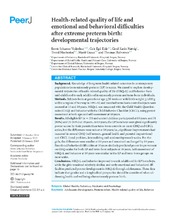| dc.contributor.author | Vederhus, Bente Johanne | en_US |
| dc.contributor.author | Eide, Geir Egil | en_US |
| dc.contributor.author | Natvig, Gerd Karin | en_US |
| dc.contributor.author | Markestad, Trond | en_US |
| dc.contributor.author | Graue, Marit | en_US |
| dc.contributor.author | Halvorsen, Thomas | en_US |
| dc.date.accessioned | 2015-08-14T07:13:44Z | |
| dc.date.available | 2015-08-14T07:13:44Z | |
| dc.date.issued | 2015-01-20 | |
| dc.identifier.issn | 2167-8359 | |
| dc.identifier.uri | https://hdl.handle.net/1956/10273 | |
| dc.description.abstract | Background: Knowledge of long-term health related outcomes in contemporary populations born extremely preterm (EP) is scarce.We aimed to explore developmental trajectories of health-related quality of life (HRQoL) and behavior from mid-childhood to early adulthood in extremely pretermand term-born individuals. Methods: Subjects born at gestational age ≤28 weeks or with birth weight ≤1,000 g within a region of Norway in 1991–92 and matched term-born control subjects were assessed at 10 and 18 years. HRQoL was measured with the Child Health Questionnaire (CHQ) and behavior with the Child Behavior Checklist (CBCL), using parent assessment at both ages and self-assessment at 18 years. Results: All eligible EP (n = 35) and control children participated at 10 years, and 31 (89%) and 29 (83%) at 18 years. At 10 years, the EP born boys were given significantly poorer scores by their parents than term-born controls on most CHQ and CBCL scales, but the differences were minor at 18 years; i.e., significant improvements had occurred in several CHQ (self-esteem, general health and parental impact-time) and CBCL (total problem, internalizing and anxious/depressed) scales. For the girls, the differences were smaller at 10 years and remained unchanged by 18 years. Emotional/behavioral difficulties at 10 years similarly predicted poorer improvement on CHQ-scales for both EP and term-born subjects at 18 years. Self-assessment of HRQoL and behavior at 18 years was similar in the EP and term-born groups on most scales. Conclusions: HRQoL and behavior improved towards adulthood for EP born boys, while the girls remained relatively similar, and early emotional and behavioral difficulties predicted poorer development in HRQoL through adolescence. These data indicate that gender and a longitudinal perspective should be considered when addressing health and wellbeing after extremely pretermbirth. | en_US |
| dc.language.iso | eng | eng |
| dc.publisher | PeerJ | eng |
| dc.rights | Attribution CC BY | eng |
| dc.rights.uri | http://creativecommons.org/licenses/by/4.0/ | eng |
| dc.subject | Adolescent | eng |
| dc.subject | Development | eng |
| dc.subject | Preterm infant | eng |
| dc.subject | Health-related quality of life | eng |
| dc.subject | Behavior | eng |
| dc.title | Health-related quality of life and emotional and behavioral difficulties after extreme preterm birth: developmental trajectories | en_US |
| dc.type | Peer reviewed | |
| dc.type | Journal article | |
| dc.date.updated | 2015-08-13T09:37:30Z | |
| dc.description.version | publishedVersion | en_US |
| dc.rights.holder | Copyright 2015 Vederhus et al. | |
| dc.source.articlenumber | e738 | |
| dc.identifier.doi | https://doi.org/10.7717/peerj.738 | |
| dc.identifier.cristin | 1250788 | |
| dc.source.journal | PeerJ | |
| dc.source.40 | 3 | |
| dc.subject.nsi | VDP::Medisinske Fag: 700::Klinisk medisinske fag: 750::Pediatri: 760 | en_US |

